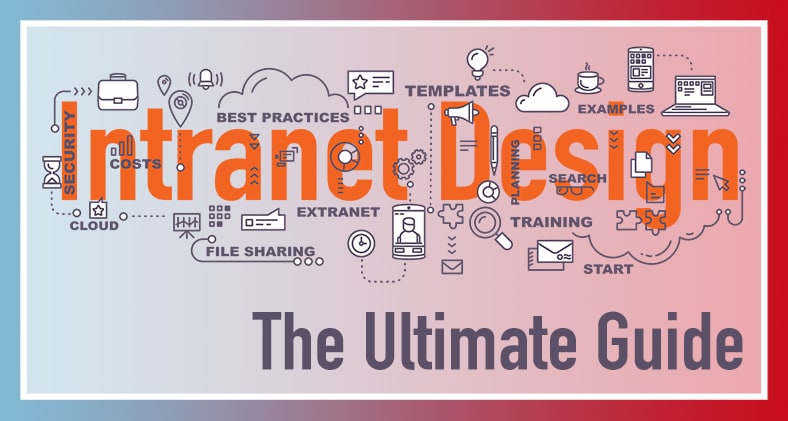Convinced by the case for an office intranet but frustrated by the lack of support from your IT department? Confused about LAN and WAN when you google “create an intranet”? Is an intranet something you’ve been considering for a while, but it all seems too complicated and you ended up in the basket too difficult? If this sounds like you, then help is at hand! In this post, we look at how to set up an intranet from a completely non-technical perspective. You’ll be amazed at how easy it is for even the average person to create a fully functional, professional intranet without the need for a college degree in computing or the support of a team of IT professionals! However, we first define what an intranet website is before looking at the benefits of creating an office intranet. We then take a look at the different types of intranets out there, including extranets and portals. Lastly, we examine the pros and cons of choosing a company network server versus a custom intranet or cloud-based hosting service. The goal of this publication is to provide you with enough information to make an informed decision about the best option for your business.
What is an intranet?
 In simple terms, an intranet is a private online network that can only be accessed by internal staff or a specially selected audience. An intranet website is a central repository for all the key information and tools your staff need to get the job done. From document management systems and file sharing to automated processes, news pages and blogs, corporate calendars and collaboration tools, the intranet offers all these essential functions in one platform with a single login.
In simple terms, an intranet is a private online network that can only be accessed by internal staff or a specially selected audience. An intranet website is a central repository for all the key information and tools your staff need to get the job done. From document management systems and file sharing to automated processes, news pages and blogs, corporate calendars and collaboration tools, the intranet offers all these essential functions in one platform with a single login.
Definition of an intranet
This is our succinct and easy-to-understand definition of an intranet: Created using Internet software, an intranet is a private internal communications platform that contains a variety of features that facilitate daily work. more efficient and effective staff.
What are the benefits of an intranet?
If you are reading this article, you are probably already thinking in creating a company intranet and are familiar with the benefits on offer. However, it is worth quickly recalling the undoubted advantages which include:
- increased workforce productivity
- simplified business processes
- better team integration and collaboration
- ease of communication
- open 24 hours a day, 24/7 access, allowing for more flexible work arrangements
- improved employee engagement rates across the company.
Simply put, a company intranet will add value to your business by helping staff members be more productive, efficient and effective. https://www.youtube.com/watch?v=VPoFtvmxIRk So now that we’ve made the business case for a company intranet, let’s look at the different types of intranets and how companies use them.
Types of intranet software
You’ve probably come across the terms intranet, extranet, and portal and wondered what the differences are. The short answer is that they are all types of intranets, but they are implemented in different situations and for specific purposes. We’ve already discussed the definition of an intranet in detail, so let’s find out more about the other two options.
Definition of an extranet
An extranet is also a closed private communications network, but the difference is that it is accessible to selected external parties such as customers, clients or suppliers. The extranet allows these external parties to more easily and efficiently communicate, collaborate, and share information directly with a business.
Types of extranets
So, in what What are the situations in which companies implement an extranet? Here are some examples of how companies have used extranet software to support their operations:
- Universities and colleges have used extranet software for fee payment and information sharing with students and parents.
- Manufacturing companies have used extranets to improve communication, collaboration, and information flow with suppliers. The extranet helps streamline the supply chain, which translates into cost reductions and improved operations.
- Graphic design companies, accountants or law firms are good examples of businesses that need to share information upside down and forwards with customers and clients regularly. These types of businesses have made extensive use of extranet software as it saves valuable time and resources, especially compared to more traditional emails or phone calls.

Defining a portal
A portal is a type of window or gateway that allows intranets or extranets to connect and integrate with business systems or applications, including CRM software or HR applications.The big advantage of using a portal is that these tools come together in a single platform with just one login Users use the same email address and password to seamlessly access all applications Staff members no longer need to remember another password or have multiple screens open at the same time.It is very convenient and allows more efficient work.
Portal software examples
The single sign-on feature along with the opportunity of accessing and integrating multiple systems and applications makes the software of po rtal is a popular choice for many businesses In addition, users can customize the applications on the portal allowing for a personalized experience tailored to their needs. Here are some real-life examples of industries using portal software:
- Insurance companies have used portal software to allow customers to manage their accounts , control purchases of products and services, as well as the use of integrated functions for payments and policy renewals.
- Real estate companiesare regular users of the portal software. They have used technology to allow users to tailor and personalize their experience with location preferences and key search criteria. Every time that user logs in, he doesn’t have to re-enter her preferences. Instead, they are presented with options based on their past browsing history. Additionally, the portal can be integrated with CRM software as well as the agent calendar for truly seamless customer service.
- Healthcare providers have used portals to Interact and connect with patients. The ability to quickly and easily schedule appointments, request refills, update personal information, access knowledge resources about conditions, treatments and general health advice makes life easier for both patients and healthcare providers.
your company, the intranet will need a server. There are two main options available:
- Use a server connected to your company network. You will need to install the intranet software on your server.
- Use a cloud-based hosting service. You pay a hosting company to host your intranet for you.
Let’s look at each option in detail.
Intranet Network Server Option the company
The decision to choose an enterprise network server can be influenced by the size of the organization and the IT resources available. Larger businesses often already have a server, while smaller organizations may need to purchase one and therefore factor that cost into your budget.  To set up the intranet, you must first install the intranet software on your server that will allow you to generate the pages and insert the content. There is a wide range of options and the one you choose will depend on its ease of use, functionality and adaptability. However, some of the standard type packages may still require a certain amount of technical knowledge. Another important point to note here is that often the software available on the market has not been specifically developed with an intranet in mind. For example, some companies have used WordPress to develop an intranet; However, while it is capable of creating a perfectly acceptable intranet, WordPress was actually developed as a website or blogging tool. So it doesn’t necessarily have all the functionality and ease of use that, for example, dedicated cloud intranet software has. Another popular software option is SharePoint. Developed by Microsoft, SharePoint might seem like a good fit for an intranet, especially if your company already uses Office 365. However, SharePoint is quite complex to set up and is often only used as a document management or storage solution. Although it can also be used to set up an intranet, it won’t check all the boxes in the same way that business user-focused intranet software will. Some companies use a consultant or have their existing web developer create the company intranet. Both are good options for those who lack technical knowledge, but will add to your costs. The main disadvantage of the network server option is that you are responsible for everything.From intranet server administration, installing updates, and backing up data to security and virus protection, you’ll need to take care of all administration and maintenance. Additionally, intranet servers take up a lot of valuable physical space, so they are not always a feasible or desirable option. Office space is, after all, an expensive commodity. https://www.youtube.com/watch?v=gxU9ZdV7BCw
To set up the intranet, you must first install the intranet software on your server that will allow you to generate the pages and insert the content. There is a wide range of options and the one you choose will depend on its ease of use, functionality and adaptability. However, some of the standard type packages may still require a certain amount of technical knowledge. Another important point to note here is that often the software available on the market has not been specifically developed with an intranet in mind. For example, some companies have used WordPress to develop an intranet; However, while it is capable of creating a perfectly acceptable intranet, WordPress was actually developed as a website or blogging tool. So it doesn’t necessarily have all the functionality and ease of use that, for example, dedicated cloud intranet software has. Another popular software option is SharePoint. Developed by Microsoft, SharePoint might seem like a good fit for an intranet, especially if your company already uses Office 365. However, SharePoint is quite complex to set up and is often only used as a document management or storage solution. Although it can also be used to set up an intranet, it won’t check all the boxes in the same way that business user-focused intranet software will. Some companies use a consultant or have their existing web developer create the company intranet. Both are good options for those who lack technical knowledge, but will add to your costs. The main disadvantage of the network server option is that you are responsible for everything.From intranet server administration, installing updates, and backing up data to security and virus protection, you’ll need to take care of all administration and maintenance. Additionally, intranet servers take up a lot of valuable physical space, so they are not always a feasible or desirable option. Office space is, after all, an expensive commodity. https://www.youtube.com/watch?v=gxU9ZdV7BCw
Cloud-hosted intranet option
Under this option, you pay for hosting online service to host your intranet site. Again, there are multiple providers, including MyHub. With a cloud-based hosting option, simply log in and create your pages and content. Most providers use pre-built intranet templates that you can easily follow and adapt to meet your organization’s requirements. In addition, the intranet can be customized to fit your company structure and your company logo, style, and colors.  The biggest advantage of hosting online is that there is no software to install or server to maintain. In fact, hosted intranet solutions are often very easy and quick to set up, requiring little to no technical knowledge. In addition, the hosting service also takes care of all technical issues, maintenance, updates, backups and security. Most hosted solutions will also provide ongoing help and support to intranet administrators. Also, intranet hosting services are usually charged monthly, so the costs are fixed. In the case of MyHub, for a flat monthly fee, businesses can enjoy unlimited users and unlimited data storage. This makes the cloud option very cost effective and also provides all the important cost certainty that is critical for businesses, particularly small businesses and startups. Another great advantage of cloud-based intranets is that staff can access them anytime, anywhere from a tablet, smartphone, or computer with Internet access. Many companies no longer operate with the traditional 9 to 5 desk work model. We are seeing more and more companies offering more flexibility and remote work. In this context, online intranets are a great advantage and help facilitate more flexible work. Therefore, when developing your intranet, it is important to ensure that the site is mobile-friendly and optimized for the smaller screens of smartphones and tablets.
The biggest advantage of hosting online is that there is no software to install or server to maintain. In fact, hosted intranet solutions are often very easy and quick to set up, requiring little to no technical knowledge. In addition, the hosting service also takes care of all technical issues, maintenance, updates, backups and security. Most hosted solutions will also provide ongoing help and support to intranet administrators. Also, intranet hosting services are usually charged monthly, so the costs are fixed. In the case of MyHub, for a flat monthly fee, businesses can enjoy unlimited users and unlimited data storage. This makes the cloud option very cost effective and also provides all the important cost certainty that is critical for businesses, particularly small businesses and startups. Another great advantage of cloud-based intranets is that staff can access them anytime, anywhere from a tablet, smartphone, or computer with Internet access. Many companies no longer operate with the traditional 9 to 5 desk work model. We are seeing more and more companies offering more flexibility and remote work. In this context, online intranets are a great advantage and help facilitate more flexible work. Therefore, when developing your intranet, it is important to ensure that the site is mobile-friendly and optimized for the smaller screens of smartphones and tablets.
Creation intranet option custom
There is one last option we should mention and that is the custom build. Some larger companies, particularly those with a strong in-house IT resource, have opted for a completely custom intranet built from the ground up. The driving force is often the desire to create a focused intranet to address specific business needs. Another attractive factor for many companies is that they retain full control over functionality, updates and hotfixes rather than delegating it to an external provider. However, there are a number of drawbacks, including the time and resources required to develop a custom intranet. In fact, the entire process from start to finish can easily take several months and many thousands of dollars.
What about intranet content?
Having considered the why and how, let’s turn our attention to the what: what content should be included on an intranet?  Since the goal of an intranet is to facilitate the working life of your staff, the best starting point to address this is the employees themselves. Consider establishing a project team with representation throughout the organization to determine what information staff need to have at their fingertips. This stage is worth investing time and effort in order to get it right. There’s no point in having a flash intranet website if your staff won’t use it because they don’t have that critical corporate information. However, your intranet likely includes some, if not all, of the following:
Since the goal of an intranet is to facilitate the working life of your staff, the best starting point to address this is the employees themselves. Consider establishing a project team with representation throughout the organization to determine what information staff need to have at their fingertips. This stage is worth investing time and effort in order to get it right. There’s no point in having a flash intranet website if your staff won’t use it because they don’t have that critical corporate information. However, your intranet likely includes some, if not all, of the following:
- email accounts
- document management systems
- corporate calendars and meeting booking systems
- knowledge management
- shared project spaces to facilitate joint work and collaboration between teams
- management task and project management
- communication tools such as blogs, discussion forums, and webinars
- automated business processes, such as booking annual leave or ordering supplies.
Draw a page sequence map on your intranet. This will give you a good idea of the general flow and sequence of information and will also help you develop a site menu. Beware of information overload.It’s tempting to put all company information on the intranet. But if it’s not relevant or staff can’t find it easily, they’ll just stop using the intranet altogether. It’s a tricky but very important balancing act.  In addition, by develop content, try to make it as engaging as possible. Company health and safety information, for example, while very important, can be a pretty dry topic. Try to bring it to life by including lots of visual interest with diagrams and photos, online quizzes or surveys, or even by injecting some humor. Keep in mind the different learning styles evident in the modern workplace, and incorporate a variety of media to meet all needs, including videos, podcasts, wikis, and webinars. Be inventive. Using some of these tricks will make your staff more likely to interact with your intranet, increasing your staff adoption rates. Finally, be sure to update your content regularly. Static images, text that doesn’t change, and even worse, outdated information is just plain boring for users. So periodically be sure to update images, review content, and get rid of anything that’s no longer relevant or up-to-date.
In addition, by develop content, try to make it as engaging as possible. Company health and safety information, for example, while very important, can be a pretty dry topic. Try to bring it to life by including lots of visual interest with diagrams and photos, online quizzes or surveys, or even by injecting some humor. Keep in mind the different learning styles evident in the modern workplace, and incorporate a variety of media to meet all needs, including videos, podcasts, wikis, and webinars. Be inventive. Using some of these tricks will make your staff more likely to interact with your intranet, increasing your staff adoption rates. Finally, be sure to update your content regularly. Static images, text that doesn’t change, and even worse, outdated information is just plain boring for users. So periodically be sure to update images, review content, and get rid of anything that’s no longer relevant or up-to-date.
Intranet design issues
Intranet design issues are a tricky topic that deserves its own dedicated post. Here we mention some of the key principles to consider and invite you to consult the Complete Guide to Intranet Design for more detailed information. The main point to get across when it comes to design is the simpler the better. Clean, uncluttered pages with lots of white space is the way to go instead of a flash intranet, all singing and dancing which is too much. For example, that purple color that looks so vibrant and flashy in your company logo can soon become annoying and overbearing when used as the background for every page on your intranet. The most successful intranets have gone for a minimalist look and present information in small, easy-to-digest chunks with the option to click for more details. 
Intranet Security
An often overlooked but important consideration when planning your intranet is security. Don’t make the mistake of thinking that because your intranet is a private communications network, it’s somehow immune to external security threats. Cybercrime continues to be a major problem. Whether it’s phishing, hacking, viruses, or ransomware, the ever-changing methods hackers implement make it a full-time job to stay on top of everything. And yet, you need to make sure that all of your company’s sensitive data and the personal data of staff and customers are as secure as possible. However, with a company network server intranet and the option of custom creation, the responsibility for security rests squarely with you. Therefore, you will need to develop knowledge and experience in firewalls, encryption technology, antivirus protection, etc. Plus, the threat of cybercrime is constantly evolving, which means you’ll need to keep your knowledge up to date. If that sounds like a daunting task, then the cloud-hosted intranet option may be a better option. Under this option, the cloud provider retains responsibility for the security of the intranet. It is up to the provider to ensure that the latest security features are implemented to protect your intranet. It is in the cloud provider’s interest to keep up with the latest techniques; after all, your livelihood depends on it.
Intranet Pilot
 Before you start using your intranet, it’s a good idea to pilot test the easier publishing material. Any online intranet provider will be happy to offer you a demo or free trial so you can fine-tune the product. A webinar or screen sharing tour is a great way to assess whether the software is a good fit for your office intranet requirements. However, there is no substitute for playing around with the software yourself. If you’ve gone down the route of a company intranet server option, then it’s worth testing the functionality and ease of use of the intranet site. You can then use the feedback to modify the layout and content as needed before it goes live to all staff. Other issues that the pilot can help you address include site permissions and access rights. Not all staff will need to access all parts of the intranet. It will be necessary to maintain the confidentiality of some information by limiting access to personnel who really need it.However, with a cloud option, the provider will have already completed all of these pre-tests and pilot tests. In fact, a cloud provider’s offering will constantly be modified and refined in response to the actual experiences of a large number of companies that use the intranet website on a day-to-day basis.
Before you start using your intranet, it’s a good idea to pilot test the easier publishing material. Any online intranet provider will be happy to offer you a demo or free trial so you can fine-tune the product. A webinar or screen sharing tour is a great way to assess whether the software is a good fit for your office intranet requirements. However, there is no substitute for playing around with the software yourself. If you’ve gone down the route of a company intranet server option, then it’s worth testing the functionality and ease of use of the intranet site. You can then use the feedback to modify the layout and content as needed before it goes live to all staff. Other issues that the pilot can help you address include site permissions and access rights. Not all staff will need to access all parts of the intranet. It will be necessary to maintain the confidentiality of some information by limiting access to personnel who really need it.However, with a cloud option, the provider will have already completed all of these pre-tests and pilot tests. In fact, a cloud provider’s offering will constantly be modified and refined in response to the actual experiences of a large number of companies that use the intranet website on a day-to-day basis.
Ask For Help!
Hopefully, we’ve now shown you that setting up an intranet may not be the technical minefield you thought it was at first. In fact, with a cloud-hosted intranet, it’s possible to have a fully-functioning, professional-looking site in no time. Contact us on MyHub for a free demo or 14-day trial and see how your business begins to enjoy the great benefits that an intranet offers.
Further reading
We have only been able to scratch the surface in this post. The MyHub blog includes a wealth of additional resources and further reading on a wide variety of topics. Whether it’s additional tips on how to implement an intranet, specialized guidelines on generating engaging content, or advice on intranet design, our blog will educate, inspire, and entertain you. Here’s a selection of what’s on offer:
The Easiest Intranet Solutions: What Are You Really Looking For?
Intranet Design: The Ultimate Guide
WordPress Intranet: 7 of the Biggest Challenges
10 Things to Consider Before Starting Your Intranet Project
Could Intranet Templates Be the Solution Your Business Needs? ?
Top 5 Tips on How to Produce Compelling Intranet Content
Post-Launch Intranet Pitfalls and Other Considerations
Intranet Platform: How to Make the Right Choice
Stop! Before you dive into your intranet project, read this post
The Easiest Intranet Solutions: What Are You Really Looking For?
Employee Intranet: 40 Great Reasons Every Business Needs One
.
